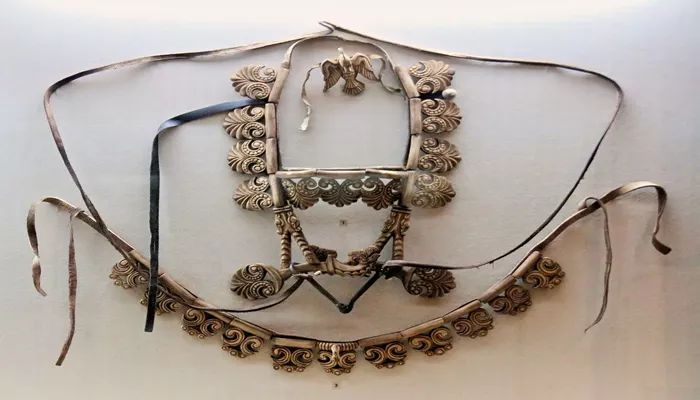The Pazyryk people, a nomadic society active between the 6th and 3rd centuries BCE, once inhabited the Altai Mountains—a region today spanning Russia, Kazakhstan, and Mongolia. Their discoveries have reshaped modern archaeology, providing fresh insights into the complexity of ancient nomadic life, marked by sophisticated burial rituals and intricate body art.
Frozen Tombs: Preserving Ancient Treasures
In the late 1940s, Soviet archaeologist Sergei Rudenko led a pioneering excavation in the Pazyryk Valley, located in the Golden Mountains of Altai. His team uncovered large burial mounds, known as kurgans, which contained wooden chambers housing not only the deceased but also their belongings.
The region’s cold climate played a crucial role in preserving these ancient relics. The permafrost caused moisture within the tombs to freeze, a process known as barrow congelation. This natural refrigeration preserved organic materials like textiles, wooden artifacts, and even human remains for millennia. Prior to interment, Pazyryk morticians employed sophisticated embalming techniques: internal organs were removed and replaced with plant matter and horsehair to maintain the body’s shape, while the skin was treated with plant extracts to delay decomposition.
As a result, archaeologists have uncovered some of the most well-preserved examples of Iron Age culture. Notably, the Pazyryk carpet—regarded as the world’s oldest surviving pile carpet—remains vibrant despite its age. Woven with intricate designs of animals such as riders, stags, and griffins, the carpet boasts a knot density of approximately 360,000 knots per square meter.
Advanced Tattoo Artistry: A Cultural Identity
The mummies found in the kurgans bore elaborate tattoos, featuring animals like deer, rams, and mythical creatures such as griffins. These tattoos are believed to have held significant cultural meaning, likely denoting social status, spiritual protection, or personal identity.
Recent technological advancements, including infrared imaging, have uncovered even more hidden tattoos, offering deeper insight into the artistry and symbolic significance of these designs. Far from being mere decoration, tattoos were integral to the Pazyryk people’s cultural and social identity, challenging the long-held belief that nomadic cultures lacked sophisticated artistic traditions.
The Role of Horses: Sacred and Symbolic
Horses were central to Pazyryk society, and this is evident in the lavish horse burials discovered within the kurgans. Many of these tombs contained horses buried alongside their owners, often adorned with ceremonial decorations. Some horses wore elaborate masks with antlers or ibex horns, indicating a spiritual or ritualistic role for these animals.
One remarkable discovery included a disassembled wagon with four large wheels, revealing that the Pazyryk had advanced transportation technology. These findings suggest a highly developed horse culture in which horses symbolized wealth, status, and a connection to the afterlife—an essential component of their nomadic lifestyle and belief systems.
Rich Artifacts and Far-Reaching Trade Networks
The Pazyryk tombs also yielded an array of intricate artifacts, pointing to a society deeply engaged in trade and craftsmanship. Among the discoveries were exquisitely carved wooden furniture, polished metal mirrors, and jewelry crafted from silver and gold. These luxury items suggest that the Pazyryk were part of a vast trade network, with connections extending as far as Persia, India, and China.
Items such as lion-shaped table legs and richly decorated felt hangings challenge the stereotype of nomadic simplicity, illustrating that the Pazyryk had a taste for fine art and sophisticated craftsmanship. The quality and variety of these artifacts highlight a society that was both wealthy and intricately woven into the broader ancient world.
The Siberian Ice Maiden: A Remarkable Find
In 1993, archaeologist Natalia Polosmak uncovered one of the most significant Pazyryk finds on the Ukok Plateau. Known as the Siberian Ice Maiden, this 25-year-old woman was buried with remarkable treasures, including six horses, a wooden coffin, jewelry, and a striking headdress. Her well-preserved tattoos, which feature intricate designs and mythical creatures, offer further evidence of the Pazyryk’s advanced body art and elaborate burial customs. This high-status burial underscores the importance of horses in Pazyryk culture and their belief in the afterlife.
Modern Research: DNA and Interdisciplinary Approaches
Today, genetic research is adding new layers to our understanding of the Pazyryk people. By analyzing DNA from mummified remains, researchers are tracing ancient migration patterns and drawing connections between Pazyryk ancestors and contemporary populations. This interdisciplinary approach—combining archaeology, genetics, and advanced imaging—has provided fresh perspectives on the Pazyryk culture and their place in human history.
Technological advancements continue to reveal new details, challenging long-standing assumptions and offering a more nuanced view of their society. However, the preservation of these ancient sites faces a significant threat due to climate change. As permafrost melts, the tombs are at risk of degradation, threatening the loss of invaluable historical data.
The Future of Pazyryk Research
Archaeologists are racing against time to document and protect these ancient sites, highlighting the urgent need to preserve cultural heritage in the face of environmental challenges. The discoveries in the Golden Mountains of Altai have forever changed how we view nomadic cultures. Once considered primitive, the Pazyryk people are now recognized for their artistic sophistication, complex social structure, and advanced cultural practices.
As ongoing research continues to unveil the richness of the Pazyryk legacy, their story challenges modern perceptions of nomadic life, adaptation, and cultural identity. The legacy of the Pazyryk serves as a testament to the resilience, creativity, and interconnectedness of ancient societies, offering profound lessons on the human capacity for innovation and cultural expression.
Related topics:

